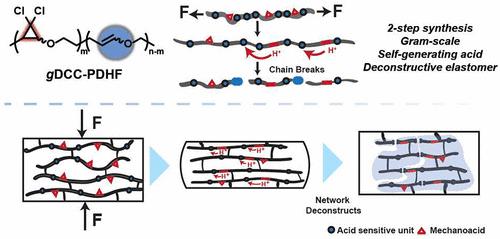当前位置:
X-MOL 学术
›
J. Am. Chem. Soc.
›
论文详情
Our official English website, www.x-mol.net, welcomes your
feedback! (Note: you will need to create a separate account there.)
Mechanically Triggered Polymer Deconstruction through Mechanoacid Generation and Catalytic Enol Ether Hydrolysis
Journal of the American Chemical Society ( IF 14.4 ) Pub Date : 2024-01-24 , DOI: 10.1021/jacs.3c10153 Yixin Hu 1 , Yangju Lin 1 , Stephen L Craig 1
Journal of the American Chemical Society ( IF 14.4 ) Pub Date : 2024-01-24 , DOI: 10.1021/jacs.3c10153 Yixin Hu 1 , Yangju Lin 1 , Stephen L Craig 1
Affiliation

|
Polymers that amplify a transient external stimulus into changes in their morphology, physical state, or properties continue to be desirable targets for a range of applications. Here, we report a polymer comprising an acid-sensitive, hydrolytically unstable enol ether backbone onto which is embedded gem-dichlorocyclopropane (gDCC) mechanophores through a single postsynthetic modification. The gDCC mechanophore releases HCl in response to large forces of tension along the polymer backbone, and the acid subsequently catalyzes polymer deconstruction at the enol ether sites. Pulsed sonication of a 61 kDa PDHF with 77% gDCC on the backbone in THF with 100 mM H2O for 10 min triggers the subsequent degradation of the polymer to a final molecular weight of less than 3 kDa after 24 h of standing, whereas controls lacking either the gDCC or the enol ether reach final molecular weights of 38 and 27 kDa, respectively. The process of sonication, along with the presence of water and the existence of gDCC on the backbone, significantly accelerates the rate of polymer chain deconstruction. Both acid generation and the resulting triggered polymer deconstruction are translated to bulk, cross-linked polymer networks. Networks formed via thiol–ene cross-linking and subjected to unconstrained quasi-static uniaxial compression dissolve on time scales that are at least 3 times faster than controls where the mechanophore is not covalently coupled to the network. We anticipate that this concept can be extended to other acid-sensitive polymer networks for the stress-responsive deconstruction of gels and solvent-free elastomers.
中文翻译:

通过机械酸生成和催化烯醇醚水解机械触发聚合物解构
将瞬态外部刺激放大并使其形态、物理状态或性能发生变化的聚合物仍然是一系列应用的理想目标。在这里,我们报道了一种包含酸敏感、水解不稳定的烯醇醚主链的聚合物,通过单次合成后修饰将其嵌入偕二氯环丙烷( g DCC)机械载体。 g DCC 机械载体响应聚合物主链上的巨大张力而释放 HCl,并且酸随后在烯醇醚位点催化聚合物解构。在含有 100 mM H 2 O 的 THF 中对骨架上含有 77% g DCC 的 61 kDa PDHF 进行脉冲超声处理 10 分钟,引发聚合物随后降解,静置 24 小时后最终分子量小于 3 kDa,而缺少g DCC 或烯醇醚的对照分别达到 38 和 27 kDa 的最终分子量。超声处理过程以及水的存在和主链上g DCC 的存在,显着加快了聚合物链解构的速率。酸的产生和由此引发的聚合物解构都转化为本体交联聚合物网络。通过硫醇-烯交联形成并受到无约束准静态单轴压缩的网络溶解的时间尺度比机械载体未与网络共价耦合的对照快至少 3 倍。我们预计这一概念可以扩展到其他酸敏感聚合物网络,用于凝胶和无溶剂弹性体的应力响应解构。
更新日期:2024-01-24
中文翻译:

通过机械酸生成和催化烯醇醚水解机械触发聚合物解构
将瞬态外部刺激放大并使其形态、物理状态或性能发生变化的聚合物仍然是一系列应用的理想目标。在这里,我们报道了一种包含酸敏感、水解不稳定的烯醇醚主链的聚合物,通过单次合成后修饰将其嵌入偕二氯环丙烷( g DCC)机械载体。 g DCC 机械载体响应聚合物主链上的巨大张力而释放 HCl,并且酸随后在烯醇醚位点催化聚合物解构。在含有 100 mM H 2 O 的 THF 中对骨架上含有 77% g DCC 的 61 kDa PDHF 进行脉冲超声处理 10 分钟,引发聚合物随后降解,静置 24 小时后最终分子量小于 3 kDa,而缺少g DCC 或烯醇醚的对照分别达到 38 和 27 kDa 的最终分子量。超声处理过程以及水的存在和主链上g DCC 的存在,显着加快了聚合物链解构的速率。酸的产生和由此引发的聚合物解构都转化为本体交联聚合物网络。通过硫醇-烯交联形成并受到无约束准静态单轴压缩的网络溶解的时间尺度比机械载体未与网络共价耦合的对照快至少 3 倍。我们预计这一概念可以扩展到其他酸敏感聚合物网络,用于凝胶和无溶剂弹性体的应力响应解构。






























 京公网安备 11010802027423号
京公网安备 11010802027423号